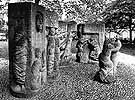
|
|
|

|

|

|

|
|
Click on an image to see a larger, more detailed picture.
|
|
|
|
|
| EPILOGUE: The Aftermath |

|
pg. 682 |

|
|
|
|
| |
 Holocaust Memorialization
Holocaust Memorialization
Since the end of World War II, hundreds of memorial institutions, monuments, and museums devoted to the Holocaust have been built in Israel, Europe, and the United States. Although every Holocaust memorial honors the millions of lives mercilessly destroyed by the Nazi regime, the subtext of the sites varies from location to location. The memorials constructed at the death camps in Poland encompass the killing of the Jews under the broader theme of "Polish national remembrance." Neither the memorial that was established at Majdanek by the Soviet liberators nor the state memorial that was built at the Auschwitz extermination camp emphasizes Jewish victimization. Both sites take a broader view, memorializing all victims of National Socialism. As in Poland, the memorials and museums in Germany also reflect on the collective entity of victims. The facility built at Dachau, Germany, has separate memorials for Protestants, Catholics, and Jews. The Berlin monument seen here commemorates gentile German women who defied the Gestapo; a Jewish-oriented Berlin monument is planned. The memorialization of the Holocaust in both the United States and Israel differs significantly from that of Europe. The sites in the U.S. and Israel typically offer extended views of Jewish history, providing detailed accounts of Jewish life in Europe before the war. They also reflect on the renaissance of Jewish life after the Holocaust. In the United States, Holocaust memorials often emphasize the importance of liberty and pluralism to the security of the American Jewish community. The national Holocaust memorial of the Jewish people in Israel, called Yad Vashem, was established by the Israeli Knesset (Parliament) in 1953. The Yad Vashem complex consists of museums and monuments as well as research, teaching, and resource centers. Yad Vashem, which means a mountain and a name, is taken from the biblical verse Isaiah 56:5: "I will give, in my house and within my walls, a monument...that shall not be cut off." Many Israeli sites focus on the range of resistance activities undertaken by Jews and the martyrdom of the Jewish people. The United States Holocaust Memorial Museum was established in Washington, D.C., in 1993. More than any other museum, it uses a full spectrum of media to "recreate" the experience of the Holocaust. Visitors read stories on plaques, view photos and film coverage, listen to hate-filled Nazi speeches, watch videotaped testimony of survivors, and use computers to research topics of their choice. Every year new Holocaust museums and memorials are planned and built. Each site offers testimony to the enormous importance attached to the Holocaust. They also provide insight into the self-perceptions of the people and nations who construct them.
Photo: Bildarchiv Preussischer Kulturbesitz
|
|

|

|

|

|
 February 16, 1987-April 18, 1988: John Demjanjuk, accused of being the Treblinka death camp's "Ivan the Terrible," is tried in Jerusalem and found guilty; See Late 1993.
February 16, 1987-April 18, 1988: John Demjanjuk, accused of being the Treblinka death camp's "Ivan the Terrible," is tried in Jerusalem and found guilty; See Late 1993.
|
 April 11, 1987: Primo Levi, an Italian-Jewish partisan who wrote numerous books about his camp experiences, takes his life.
April 11, 1987: Primo Levi, an Italian-Jewish partisan who wrote numerous books about his camp experiences, takes his life.
|
 May 11-July 4, 1987: Former SD/SS officer Klaus Barbie is tried in Lyons, France, for war crimes and sentenced to life imprisonment.
May 11-July 4, 1987: Former SD/SS officer Klaus Barbie is tried in Lyons, France, for war crimes and sentenced to life imprisonment.
|
 August 17, 1987: Former Deputy Führer Rudolf Hess, imprisoned by the Allies since 1941 and interned at Spandau Prison since 1946, dies, an apparent suicide, at age 93.
August 17, 1987: Former Deputy Führer Rudolf Hess, imprisoned by the Allies since 1941 and interned at Spandau Prison since 1946, dies, an apparent suicide, at age 93.
|
 September 1987: Canadian law is changed to allow the prosecution of former Nazis currently living in Canada.
September 1987: Canadian law is changed to allow the prosecution of former Nazis currently living in Canada.
|
 1988: The U.S. Office of Special Investigations (OSI) maintains active investigations of 600 suspected former Nazis living in America.
1988: The U.S. Office of Special Investigations (OSI) maintains active investigations of 600 suspected former Nazis living in America.
|
|
|
|
|
| EPILOGUE: The Aftermath |

|
pg. 682 |

|
|
The Holocaust Chronicle
© 2009 Publications International, Ltd.
|
|
